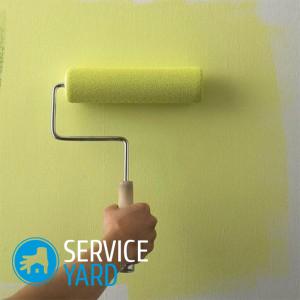How to paint drywall?

Any person who is at least a little versed in building materials will agree that it is possible to perfectly align the ceiling and walls only with the use of drywall. In addition, with its help you can create relief surfaces with several levels and bizarre shapes. But simply aligning the walls is not enough; they need to be given a complete look. And in this case, the best option is to paint the surface, because with the help of paint you can not only beautifully design the walls, but also apply interesting drawings and applications to them. In our article, we will tell you how to paint drywall so that the result of the work exceeded all expectations. Even a beginner can cope with this work, the main thing is to strictly follow the instructions.
to contents ↑What kind of paint is better to paint drywall walls?
In order to quickly and efficiently paint plasterboard walls, it is necessary to use not only special equipment, but also suitable coloring materials. Their choice depends on the purpose of the room. More often today they use oil paints, enamels and water-based solutions. Now consider each option in more detail.
Water based paints
They perfectly combine excellent quality and a pleasant price. Thanks to them, drywall surfaces become velvety and matte. In turn, such paints are divided into:
- acrylic;
- silicate;
- water emulsion;
- silicone;
- water dispersion.
Important! Aqueous emulsion formulations, as a rule, are produced in white. To give them the necessary shade, you can use a special dye, which can be found in any hardware store.
Water based paints
They should be considered as a separate category, as they are suitable for use in all types of residential premises. But in conditions of high humidity it is still better to prefer paints and varnishes that normally tolerate such differences, for example, acrylic paints. They do not allow the fungus to develop and do not leak condensate.
Enamel and oil paints
 They are used in almost all rooms, because they are not afraid of dampness and moisture. To the touch, such paints are cool, and outwardly shine beautifully. In addition, they are quite economical in terms of consumption per meter of working surface.
They are used in almost all rooms, because they are not afraid of dampness and moisture. To the touch, such paints are cool, and outwardly shine beautifully. In addition, they are quite economical in terms of consumption per meter of working surface.
Important! The only drawback of such compositions is that the painting should be done only in a well-ventilated area, because they contain harmful chemical elements.
In principle, to choose independently what paint to paint drywall with, perhaps the most important thing is to carefully study the properties of all coloring compounds.
to contents ↑Important! Keep in mind that water-based paints after completely drying become a little lighter, but oil and enamel - on the contrary, darken.
How to choose tools for painting drywall walls?
As a rule, plasterboard walls are painted using brushes, rollers and spray guns:
- Of course, the easiest way to achieve high-quality and uniform painting is to use a spray gun. But it’s not cheap, although you can try to rent this tool.
- Brushes of various diameters and sizes are used to process the most inaccessible places, in particular angles, protrusions and small gaps.
Important! The most popular are small flange brushes with a width of not more than 10 millimeters.
- Work with a roller is considered the most productive, but with such staining, you have to combine its use with brushes in order to get a high-quality and uniform layer.
Choosing the right roller
- When choosing a roller, it is better to give preference to a tool with a natural pile, because it is suitable for paints of all varieties.
- Foam rollers are used for applying water-based paints.
- Moreover, the roller along the length of the pile is selected depending on the type of paint chosen:
- For glossy paints, short-pile rollers of no more than 4 millimeters are suitable.
- For matte paints, a roller with a medium-length pile, not more than 8 millimeters.
- To give the surface texture use rollers with a long pile, from 8 millimeters.
Important! Mostly people prefer tools with a pile of 4 to 8 millimeters in length, because they do not absorb too much paint and do not leave bald patches on the walls.
- When choosing a roller, you need to pay attention to the length of the working surface, so that it does not exceed 200 millimeters.
- It will be great if, in addition to the purchased tool, there will also go a telescopic pipe, thanks to which there is no need to use a stepladder for painting joints.
How to prepare drywall walls for painting?
Any painting of walls made of drywall with your own hands begins with the preparation of surfaces. This stage is quite responsible, and the final result of painting will depend on the quality of all work.
Preparatory work involves priming the walls, puttying the joints, the common surface and applying the finish primer.
All work is performed in the following order:
- Priming is best done with a foam roller. First, a special acrylic primer is applied to it, and then it is rolled on the surface until completely absorbed. In places where it is difficult to get, you can use a brush.
- After the primer dries, it is possible to putty all the recesses and joints. Apply a putty on the joints between the sheets of drywall with a thin layer with a spatula.
- It is not necessary to wait for the mixture to dry. Now we glue the reinforcing tape along the entire length of the seam, and cover it with a layer of putty on top.
- We take two spatulas and put the finishing putty on the recesses of the screws, and then we also process the surface of the walls.
- As soon as the putty dries, you need to carefully grind all the seams and indentations with sandpaper. The smoothness of the surface of the walls will depend on how well you do it.
- Using the building level, we check the evenness of the walls. It must be applied to the surface in any direction. If you find excess bulges or gaps, they will need to be additionally wiped.
- Now we carry out the final primer of the walls. It is necessary to walk on the walls with acrylic primer two times in a row.
to contents ↑Important! Before painting drywall make sure that it is perfectly sanded. The quality of the preparatory work can be checked using a flashlight or lamp, you just need to direct the rays of light at different angles to the wall.
How to paint drywall walls?
And now we proceed to the most important thing - we learn how to paint plasterboard walls. Whatever paint you choose, it will need to be applied to the walls in several layers, and each time you need to wait until the previous layer has completely dried.
Important! The fact is that through one layer seams, filler irregularities, differences in structure and color can be seen through. Subsequent layers will help align the overall texture and color.
To make it more convenient to work, the paint is poured into a special container in which it is convenient to dip the roller and brush on the side.To perfectly paint the walls, follow the instructions below:
- We start by applying a brush, with which we paint the entire perimeter of the working surface, and also draw around obstacles, that is, all the protrusions, sockets for sockets and switches. Due to this approach, you can avoid paint pollution barriers.
- Before you start painting with a roller, you need to completely dip it in a bucket of paint so that it is saturated with it as much as possible.
- You need to start painting from the corners of the room, in the direction from the ceiling to the floor, regardless of the type of paint chosen.
- Getting to work with each new surface, you again need to mark the perimeters with a brush.
- The paint is applied by the roller all the time in one direction, and the first, second and even third layer.
- So that it is evenly distributed, it is enough to walk along one strip only three times.
- Walls of large area are recommended to be painted with strips perpendicular to the direction of the roller. And remember: you cannot paint over areas where the paint has already set, but has not completely dried out.
- Stir the paint constantly so that it does not thicken and the color remains uniform. Aqueous emulsion composition can be diluted with water, and oil paint with a solvent.
- The final layer of paint is applied only after all the previous layers have completely dried.
- If somewhere there are traces of water-based paint, then they can be removed with sandpaper after it dries. The glossy composition is more difficult to remove, so all the shortcomings will have to be carefully masked with an additional layer of paint.
Stock footage
As you can see, even without special skills, you can cope with painting plasterboard walls yourself. The main thing is to follow certain rules and technologies.
- How to choose a vacuum cleaner taking into account the characteristics of the house and coatings?
- What to look for when choosing a water delivery
- How to quickly create comfort at home - tips for housewives
- How to choose the perfect TV - useful tips
- What to look for when choosing blinds
- What should be running shoes?
- What useful things can you buy in a hardware store
- Iphone 11 pro max review
- Than iPhone is better than Android smartphones



